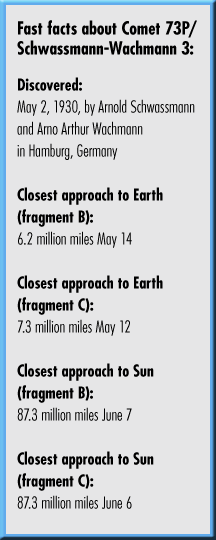
Matt Quandt
Assistant editor
[t] 262.796.8776 x419
[e] mquandt@astronomy.com
May 5, 2006
WAUKESHA, WI – If predictions hold, viewers could be in for a great nighttime show this month as the year’s brightest comet passes close to Earth. Unfortunately, there are no guarantees – Comet 73P/Schwassmann-Wachmann 3 could just as easily fizzle out. Professional astronomers and backyard observers alike will keep their eyes on the sky during the next few days and weeks to see what develops. They’re guardedly optimistic that the comet will be bright enough to see from a city park with the naked eye.
The uncertainty arises because the comet’s icy nucleus has split into more than 40 pieces. Each chunk glows as sunlight warms its surface and causes the ice to turn directly to gas. Not only does sunlight cause this gas to glow, but the erupting gas liberates lots of dust, which also reflects incoming sunlight. Some of the fragments likely will dissolve totally. However, the two biggest pieces, designated fragments B and C, should approach naked-eye visibility when they come closest to Earth next week. They will be easy to spy through binoculars or a small telescope from a dark site. And if one of the big chunks splits further – exposing fresh ice to the Sun’s glare – it could flare spectacularly.
The comet spends the next week in the vicinity of the constellation Cygnus the Swan, which appears high in the northeast around local midnight.
More Astronomy resources:
Astronomy news
This week’s sky events
Astronomy basics
Glossary of astronomical terms
Return to Astronomy “For the media” page
Fragment B (pictured above) makes its closest approach to Earth May 14, when it comes within 6.2 million miles of our planet. Fragment C pulls within 7.3 million miles of Earth May 12. No fragment will come closer than 5.5 million miles – more than 20 times the Moon’s distance. Although the comet fragments should glow brightest at closest approach, the Moon appears full the night of May 12/13, and its light will hinder observations. Better views likely will come beginning 3 or 4 days later.
Historical perspective
Comet 73P/Schwassmann-Wachmann 3 didn’t start out in so many pieces. In May 1930, German astronomers Arnold Schwassmann and Arno Arthur Wachmann discovered the comet. Although the comet orbits the Sun in slightly more than 5 years, poor observing conditions meant it wasn’t spotted again until 1979. It was missed in 1984 but recovered in 1989, and has been seen at each return since then.
In autumn 1995, the comet suddenly and unexpectedly flared up, brightening by a factor of 1,000. Soon thereafter, astronomers discovered the comet had split into five fragments. At its last return in 2001, only three of the five fragments remained, the rest presumably had broken up entirely. Now, the comet seems to be in its death throes. As it continues to fragment, the pieces will waste away. No one knows whether any of the comet will remain at its scheduled return 5 years from now.









